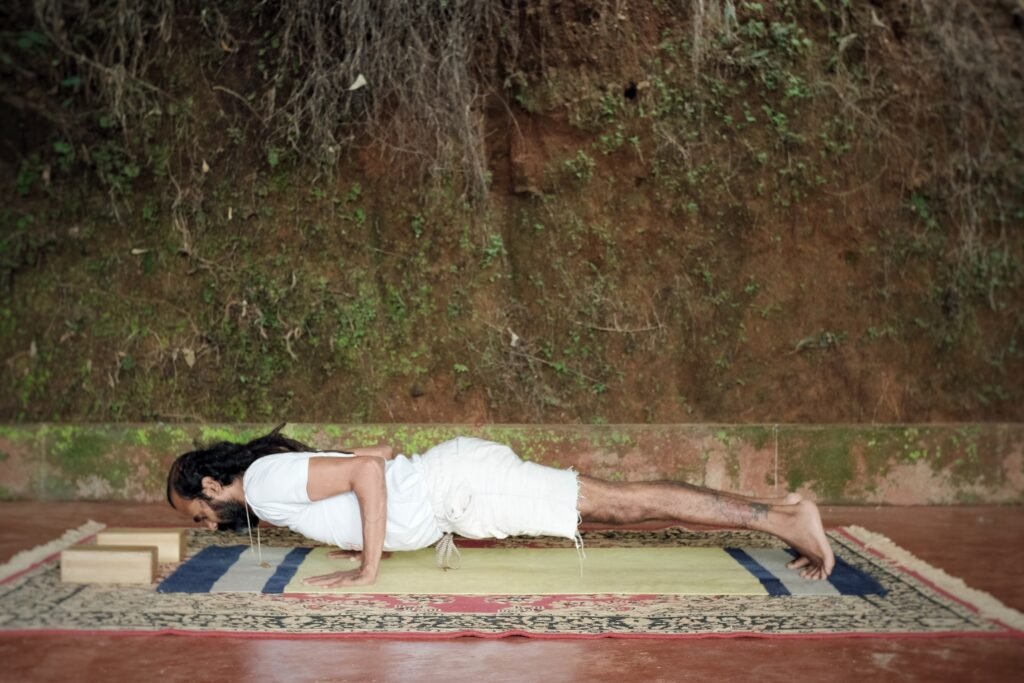
Chatur means “four limbs” in Sanskrit, danda “supporting staff,” and asana “posture” The spinal cord, which serves as the body’s primary support system, is referred to as the staff in the four-limbed staff pose (Chaturanga Dandasana).
The four-limbed staff pose, part of the Surya Namaskar (Sun Salutation) short flow, is thought to strengthen the shoulders, arms, and core. It is also included in the Classic Sun Salutation Variation IV (Classic Surya Namaskar Variation iv).
This adaptable transit pose is used in various fitness styles, including Power Yoga, Vinyasa, Ashtanga Yoga, Gym, Pilates, and free floor exercises.

Chaturanga Dandasana steps
- Start in the downward-facing dog position (Adho Mukha Svanasana), then transition into plank pose (Note that your shoulder bones are pushed immovably against your back, and your tailbone is pushed towards the pubis.)
- Keep your arms fully extended, and maintain a straight spine.
- Exhale, bend your elbows, keep your lower body low but not touching the ground, and stop when you are just a few inches from the floor or ground.
- Keep your hips straight and your body parallel to the ground. In this position, tuck your legs in.
- Maintain plenty of room between your shoulder blades.
- Instead of spreading your elbows outward, you should push them back toward your heel.
- Press the tips of your forefinger firmly into the ground while ensuring your neck is aligned straight with the rest of your body.
- Hold this position for 10 to 30 seconds before exhaling and laying gently on the floor.
- Carry out this procedure three to six times.
Benefits of the Four-Limbed Staff Pose:
Lengthen, strengthen, and stretch:
The muscles surrounding the upper arms are encouraged to expand and contract with breathing and gain strength by regularly balancing the body on the arms. The alignment strengthens the shoulders by utilizing the shoulder blades to support the arms. As the alignment engages the core, this pose strengthens the core.
The body is held nearly parallel to the floor thanks to the strength of the abdominal muscles.
Flexibility and range of motion:
An essential component of the four-limbed staff pose is bending the elbows, which strengthens the arm muscles while enhancing the flexibility of the wrists and elbows in addition to the arm muscles. As the student holds the pose by involving the hips, it strengthens them.
Students advance to challenging arm-balancing postures like Headstand Pose (Sirsasana), Forearm Side Plank, Feathered Peacock Pose (Pincha Mayurasana), Headstand Pose Wide Legs (Salamba Sirsasana Konasana), etc. with regular practice.
Awareness and Focus (Concentration):
The student maintains attention on the alignment and core during the four-limbed staff yoga pose. The essential components of this pose are:
- The proper alignment of the spine without lifting the hips high.
- Support for the arms with bent elbows.
- Support for the foot with curled toes.
The concentration required to hold this posture while being aware of your breathing improves both your physical stability and your mental agility.
Alignment and Posture:
A strong and self-assured posture is best achieved with well-toned arms, legs, and core. The main branch of the body’s tree, the spine, is toned in Chaturanga Dandasana, and this toning improves the body’s equilibrium and spinal health.
Energizing, De-stressing, and Relaxing:
This pose is energizing, providing the body with the necessary energy and momentum to move into deeper vinyasa flows. Yoga instructors can use this pose to sculpt yoga flows and sequence core strengthening.
Stimulation and Organs:
As this pose strengthens the abdominal muscles from the core, the abdominal organs start to function more efficiently, which improves the digestive system. Without a doubt, practicing this pose repeatedly is necessary.
Balance and Emotions:
The difficult pose gives the practitioner more self-assurance. It opens the Manipura Chakra, also known as the Nabhi Chakra, which assists a person in balancing their emotional quotient.
The pose requires physical stability, which improves mental fortitude as well. The prana (life force) is in harmony and moves fluidly throughout the body.
Others:
Because this pose requires joint and core strength, only physically fit people can perform it. It’s a good practice for athletes, teenagers, marathon runners, and other sportspeople.
Contraindications for Four-Limbed Staff Pose:
- Injury and Surgery: If you have suffered an injury to your arms, wrists, ankles, shoulders, or feet, you shouldn’t perform the four-limbed staff pose. Avoid this pose if you’ve had surgery on your spine, shoulders, knees, hips, or abdomen.
- Lack of Body-Breath Connections: If this pose is performed independently, students who lack breath body awareness may hold their breath, which is not recommended. Teachers should teach such students about breath awareness before entering the pose and be reminded of their breath if they are holding it.
Breath awareness is necessary for balancing the body with core strength. If the teacher notices the student is struggling, they should avoid the pose to prevent suffocation or injuries.
- Physical Strength and Weak Body: Students with weak wrists, arms, shoulders, or ankles should avoid this pose to prevent joint damage.Four limbed staff pose requires energy and tests the lethargy and sluggishness of students dealing with trauma and anxiety.
Additionally, this pose should be avoided by those who suffer from vertigo, high blood pressure, or migraines. Dizziness and imbalance can lead to injuries of any kind.
Patients with carpal tunnel syndrome should avoid plank pose because it puts pressure on the wrists and elbows.
- Others: Pregnant women, children, senior citizens, and post-natal women should avoid this balance pose because it requires both arm and core strength. Yoga instructors need to know that this pose is less restorative and more rehabilitative. Yoga instructors should avoid this difficult pose when it is part of a therapy session for frail students, the ill, or elderly clients.
